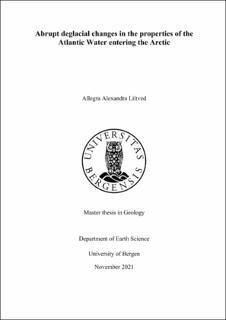Abrupt deglacial changes in the properties of the Atlantic Water entering the Arctic
Master thesis
Permanent lenke
https://hdl.handle.net/11250/2834286Utgivelsesdato
2021-12-15Metadata
Vis full innførselSamlinger
- Master theses [112]
Sammendrag
The Arctic Ocean and Barents Sea are currently experiencing rapid changes, with recent reductions in sea ice being linked to increased heat transport by warm Atlantic Water (AW) flowing into the Arctic Ocean. Knowledge of past ocean-climate-sea ice variability provides a crucial reference for understanding and contextualizing these ongoing changes. The last glaciation experienced numerous abrupt perturbations in the climate-ice-ocean system that can provide important exemplars for elucidating the coupling and sensitivity of this system. The most recent event being the Younger Dryas (YD) (12 900 – 11 700 cal yr BP). Despite this, the variability of AW properties inflowing to the Arctic and their relationship to ocean circulation and sea ice during the YD remains equivocal, due to there being few high- resolution proxy records covering this interval in the northern Barents Sea and Arctic Ocean. Here I present high resolution stable isotope records (δ18O and δ13C) of planktic and benthic foraminifera, for the late Bølling-Allerød, Younger Dryas and early Holocene, from a sediment core (KH18-10-14-GC-1) from the Kvitøya Trough (80.69°N, 28.95°E). Subsurface properties at this location are influenced by, and thus provide a monitor of, the Svalbard Branch of AW inflowing to the Arctic. A rapid decrease in 𝛿18O of 1.28-2‰ occurs early in the Younger Dryas (YD) at 12 500 ± 280 cal yr BP in both the planktic and benthic records and persists for approximately 500 years. This isotope anomaly indicates that a large warming (or freshening) event of as much as 5 – 8 °C influenced both the near surface and bottom water through the first part of the YD. The magnitude of this inferred AW warming is consistent with models and proxy results investigating other millennial scale stadial cold periods. The low 𝛿18O interval is concomitant with increased local sea ice cover and a weakened Atlantic Meridional Overturning Circulation. Variations in sea ice extent during the YD may explain how these events are linked. Expanding sea ice limits AW’s exposure to the atmosphere and heat (buoyancy) loss, reducing the density and formation of deep water. The subsequent decrease of sea ice and AW temperature at 12 000 cal yr BP is consistent with an increase in heat loss, suggesting deep water formation recovered through the latter portion of the YD. Thus, sea-ice, ocean-heat transport, and overturning circulation appear consistently coupled during abrupt climate change events. These natural perturbations appear different in pattern to that found for the current sea ice reduction, suggesting different underlying causes.
